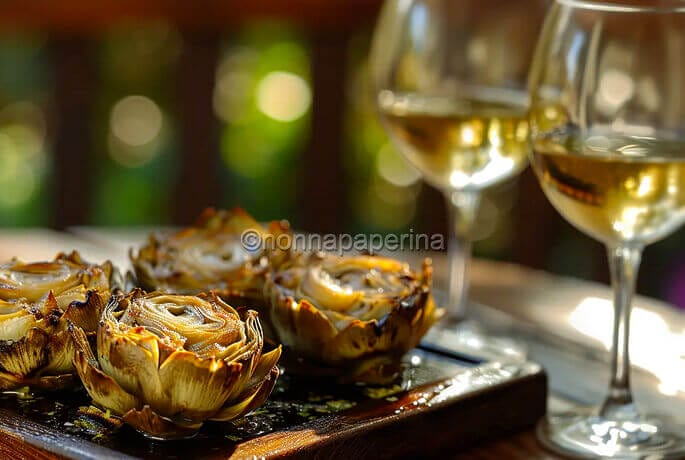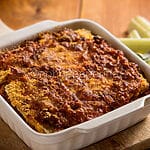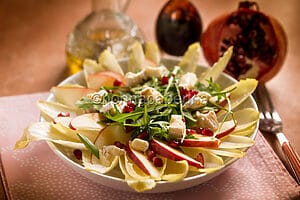
Cardoons with Parmesan, an easy and tasty dish from Umbria

Cardoons with Parmesan, a simple traditional dish that is rich in flavour
A highly specific variation of the more well-known eggplant parmigiana dish is called Cardoons with Parmesan. Contrary to popular belief, nevertheless, this meal is not experimental; rather, it is a part of Umbrian cuisine’s most well-liked tradition. The fact that the most authentic form of it also has Norcia sausage, a traditional Umbrian product, is no accident.
An additional oddity is the way cardoons are handled. These are fried with a very excellent breading that consists of flour and an egg-based solution (yolk and egg white), rather than just boiled and used to build the layers.
As a result, some claim the meal tastes even better than the traditional Parmigiana, which is more dense. Due to its abundance of ingredients and high nutritional value, this dish looks fantastic served on Sunday tables.
Recipe cardoons with parmesan
Preparation cardoons with parmesan
- To prepare the Cardoons with Parmesan follow these simple steps. Clean and remove the cardoons filaments.
- Then cut them into pieces of 10 cm each and place them in a bowl with slightly acetate water to preserve their colour.
- Cook the cardoons in boiling water enriched with lemon juice for 20 minutes or more, then drain them and let them cool.
- Attend to the sauce in the interim. Chop the onion, carrot, and celery. Add the crumbled and peeled sausages and sauté them in two tablespoons of extra virgin olive oil.
- After a few minutes of cooking, add the puree to the sausages. Add the salt at the end, and simmer for another 20 minutes.
- The cardoons should now be dried, floured, and dipped in the eggs with a small amount of salt.
- Fry the cardoons a little at a time, turning them at least once. When they turn golden, remove them and let them rest on kitchen paper.
- It is now time to make the parmigiana. Distribute a few spoonfuls of sauce in the bottom of a baking dish and arrange the fried cardoons well aligned on it so that they touch each other. Cover them with the sauce, and finish with a generous sprinkle of grated Parmesan.
- Create a second layer now by adding extra Parmesan, sauce, and cardoons. To assemble the third layer, repeat the process and add the Parmesan last.
- Bake the parmigiana for 20 minutes at 180 degrees in a preheated oven. Use the grill for the final five minutes of cooking.
Ingredients cardoons with parmesan
- 900 gr. of cardoons
- 2 eggs
- q.b. of rice flour
- 150 gr. of grated Parmigiano Reggiano (or Pecorino)
- 2 sausages (if possible
- Norcia sausage)
- 500 gr. of tomato puree
- 1 stick of celery
- a small onion
- 1 carrot
- 1 lemon
- 4 tablespoons extra virgin olive oil
- q.b. of peanut oil
- a pinch of salt
What to know about cardoons
The most unique component of this Parmigiana are the cardoons, so it’s helpful to go deeper into the subject. Due to their rustic flavour, cardoons are a highly excellent vegetable that resembles artichokes. Moreover, the leathery leaves that cover cardoons frequently need to be removed. To keep the remaining ones from blackening, they need to be sliced into pieces, extracted from the stem filaments, and submerged in acidulated water for a short while.
Cardoons are also excellent from a nutritional point of view. They are rich in vitamin C, potassium, and fiber. Furthermore, they exert a diuretic and hepatoprotective function as they help purify the body. Finally, the calorie intake is very low and stands at 20 kcal per 100 grammes.
Sausage in Cardoons with Parmesan?
As I have already mentioned, another difference between the cardoon with parmesan (also called “gobbi alla Perugina”) and the eggplant parmigiana lies in the sauce. The latter is not smooth, i.e., composed only of tomato puree, but rather enriched with sausage. Any kind of pork sausage will work, but Norcia sausage is a wonderful choice because of its unique blend of subtle and rustic flavours and its tender texture that works well in a variety of cuisines.
Either way, the sausage is cooked on a traditional sauté of onions, carrots, and celery after being peeled and crushed. Since the sausage needs to be felt in all its strength, subtlety is not required.

Add the tomato puree and simmer for a few more minutes. After that, it simmers for a further twenty minutes, or until the sauce has somewhat reduced. Since the sauce will need to serve as both a base and an intermediate layer, it doesn’t have to be excessively thick. Additionally, keep cooking in the oven with the pre-made parmesan.
The many variations of Parmigiana
There is much to explore in the world of Parmigiana. Apart from the distinct cardoon with parmesan, there exist several variants, and countless more can be devised utilising one’s creativity. It’s crucial to adhere to the basic process, which involves layering tomato sauce and the main ingredient—which can be changed—in succession.
In addition to eggplants, it is possible to use zuchini, which does not need to be cooked completely before placing them in the oven; a light blanching is often sufficient. Pumpkin parmigiana is also excellent, which is often “white” as the tomato tends to cover its flavor. It is not uncommon for some cold cuts with a delicate flavor to be added, such as bacon or cooked ham.
The parmigiana peppers are also very good. In this case, the peppers must be peeled so that the peel does not come between the pulp and the sauce, resulting in a dish that is too “disconnected.” Removing the skin from peppers may seem difficult, but it’s child’s play if you use the right methods. Here’s how to best peel peppers.
And what about artichoke parmigiana? In flavour and structure, it is similar to the cardoon and is also popular for its extremely rustic character and satiating capacity.
Cardoon with Parmesan FAQs
How to clean cardoons?
To clean the cardoons, simply wash them and remove the filaments. If they are leathery, like artichokes, it is necessary to remove the external leaves.
How are fried cardoons prepared?
To prepare the fried cardoons, it is necessary to cut the cardoons into pieces and dip them first in the flour and then in the egg. They are then cooked in a lot of hot oil and allowed to drain on absorbent paper.
How are cardoons with parmesan made?
Cardoons with parmesan are made exactly like classic Parmigiana. The only differences concern the cardoon layers and the preparation of the sauce. The latter is enriched with sausage and resembles a sort of ragù.
All rights reservedCOULD IT BE INTERESTING FOR YOU

Roman-Jewish fried artichokes, a traditional Roman dish
Origins and curiosities of Roman-Jewish fried artichokes Roman-Jewish fried artichokes are one of the most famous and delicious dishes in Roman cuisine. Their origin dates back to the 16th century,...

Camembert and apple salad, a sweet and savoury...
A focus on Camembert The Camembert cheese is the primary component of this salad. This is no ordinary white rind cheese; its "delicate flavour" brings out the sweetness of fresh fruit and the body...
















